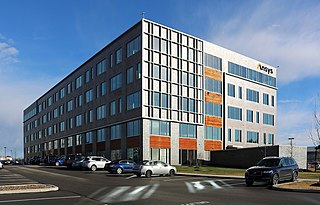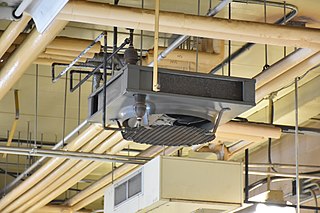Related Research Articles

A pump is a device that moves fluids, or sometimes slurries, by mechanical action. Pumps can be classified into three major groups according to the method they use to move the fluid: direct lift, displacement, and gravity pumps.

A submersible pump is a device which has a hermetically sealed motor close-coupled to the pump body. The whole assembly is submerged in the fluid to be pumped. The main advantage of this type of pump is that it prevents pump cavitation, a problem associated with a high elevation difference between pump and the fluid surface. Submersible pumps push fluid to the surface as opposed to jet pumps which create a vacuum and rely upon atmospheric pressure. Submersibles are more efficient than jet pumps. Hydraulic submersible pumps (HSP's) use pressurised fluid from the surface to drive a hydraulic motor downhole, rather than an electric motor, and are used in heavy oil applications with heated water as the motive fluid.

Hydraulic shock is a pressure surge or wave caused when a fluid, usually a liquid but sometimes also a gas, in motion is forced to stop or change direction suddenly; a momentum change. This phenomenon commonly occurs when a valve closes suddenly at an end of a pipeline system, and a pressure wave propagates in the pipe.

Hydraulic engineering as a sub-discipline of civil engineering is concerned with the flow and conveyance of fluids, principally water and sewage. One feature of these systems is the extensive use of gravity as the motive force to cause the movement of the fluids. This area of civil engineering is intimately related to the design of bridges, dams, channels, canals, and levees, and to both sanitary and environmental engineering.

Within industry, piping is a system of pipes used to convey fluids from one location to another. The engineering discipline of piping design studies the efficient transport of fluid.
The London Hydraulic Power Company was established in 1883 to install a hydraulic power network in London. This expanded to cover most of central London at its peak, before being replaced by electricity, with the final pump house closing in 1977.

Hydraulic machines use liquid fluid power to perform work. Heavy construction vehicles are a common example. In this type of machine, hydraulic fluid is pumped to various hydraulic motors and hydraulic cylinders throughout the machine and becomes pressurised according to the resistance present. The fluid is controlled directly or automatically by control valves and distributed through hoses, tubes, and/or pipes.

Ansys Inc. is an American public company based in Canonsburg, Pennsylvania. It develops and markets engineering simulation software. Ansys software is used to design products and semiconductors, as well as to create simulations that test a product's durability, temperature distribution, fluid movements, and electromagnetic properties.

Hydronics is the use of a liquid heat-transfer medium in heating and cooling systems. The working fluid is typically water, glycol, or mineral oil. Some of the oldest and most common examples are steam and hot-water radiators. Historically, in large-scale commercial buildings such as high-rise and campus facilities, a hydronic system may include both a chilled and a heated water loop, to provide for both heating and air conditioning. Chillers and cooling towers are used either separately or together as means to provide water cooling, while boilers heat water. A recent innovation is the chiller boiler system, which provides an efficient form of HVAC for homes and smaller commercial spaces.

Thermosiphon is a method of passive heat exchange, based on natural convection, which circulates a fluid without the necessity of a mechanical pump. Thermosiphoning is used for circulation of liquids and volatile gases in heating and cooling applications such as heat pumps, water heaters, boilers and furnaces. Thermosiphoning also occurs across air temperature gradients such as those utilized in a wood fire chimney or solar chimney.

National Oilwell Varco (NOV) is an American multinational corporation based in Houston, Texas. It is a leading worldwide provider of equipment and components used in oil and gas drilling and production operations, oilfield services, and supply chain integration services to the upstream oil and gas industry. The company conducts operations in more than 600 locations across six continents, operating through three reporting segments: Rig Technologies, Wellbore Technologies, and Completion & Production Solutions.
Hydropneumatic devices such as hydropneumatic accumulators or pulsation dampeners are devices which prevent, but do not absorb, alleviate, arrest, attenuate, or suppress a shock that already exists, meaning that these devices prevent the creation of a shock wave at an otherwise earlier stage. These can include pulsation dampeners, hydropneumatic accumulators, water hammer preventers, water hammer arrestors, and other things.
Victaulic is a developer and producer of mechanical pipe joining systems and is the originator of the grooved pipe couplings joining system. Victaulic is a global company with 15 major manufacturing facilities, 28 branches, and over 3600 employees worldwide. Currently, Victaulic headquarters is located in Easton, PA. John F. Malloy has served as CEO since 2002.

Danfoss Power Solutions designs, manufactures, and markets engineered hydraulic and electronic systems and components for use primarily in applications of mobile equipment. The company has sales, manufacturing, and engineering capabilities globally.
ROHR2 is a pipe stress analysis CAE system from SIGMA Ingenieurgesellschaft mbH, based in Unna, Germany. The software performs both static and dynamic analysis of complex piping and skeletal structures, and runs on Microsoft Windows platform.
Thermodynamic pump testing is a form of pump testing where only the temperature rise, power consumed, and differential pressure need to be measured to find the efficiency of a pump. These measurements are typically made with insertion temperature probes and pressure probes fitted to tapping points on the pump's inlet and outlet. From these measurements, the flow produced by a pump can be derived. The thermodynamic method was developed in the early 1960s, and since has been increasingly used. It is described in high precision hydraulic testing standards such as ISO 5198.

A tube, or tubing, is a long hollow cylinder used for moving fluids or to protect electrical or optical cables and wires.

EPANET is a public domain, water distribution system modeling software package developed by the United States Environmental Protection Agency's (EPA) Water Supply and Water Resources Division. It performs extended-period simulation of hydraulic and water-quality behavior within pressurized pipe networks and is designed to be "a research tool that improves our understanding of the movement and fate of drinking-water constituents within distribution systems". EPANET first appeared in 1993.
A pipe support or pipe hanger is a designed element that transfer the load from a pipe to the supporting structures. The load includes the weight of the pipe proper, the content that the pipe carries, all the pipe fittings attached to pipe, and the pipe covering such as insulation. The four main functions of a pipe support are to anchor, guide, absorb shock, and support a specified load. Pipe supports used in high or low temperature applications may contain insulation materials. The overall design configuration of a pipe support assembly is dependent on the loading and operating conditions.

Flowmaster Ltd. was a leading British Engineering Simulation Software company based in Towcester, UK. Its flagship 1D CFD product, also named ‘Flowmaster’, was fir2st released commercially in 1987 although initial versions went back to the early 1980s having originated from BHRA, the not-for-profit British Hydromechanics Research Association, later to become the BHR Group.
References
- ↑ "Release Of PIPE-FLO Compressible 2007 Software". Impeller.net. 8 August 2007. Retrieved 2 May 2012.
- ↑ Jackson, Kim M. (1 December 2001). "HP Informer". Hydrocarbon Processing. Archived from the original (Fee required) on 14 February 2015. Retrieved 2 May 2012.
- ↑ "File Extension .PIPE Details". Filext.com. Retrieved 2 May 2012.
- ↑ "Engineered Software's FFT Offers 'Pump Training' Course". Tenlinks. 24 July 2008. Archived from the original on 14 February 2015. Retrieved 2 May 2012.
- ↑ "Engineered Software, Inc. and Crane Valve North America enter into four-year agreement". Engineered Systems Magazine. 13 June 2006. Retrieved 2 May 2012.
- ↑ "CRANE Fluid Handling prepares new Metric (SI Units) TP-410". Crane Fluid Handling. Retrieved 2 May 2012.
- ↑ "Pump Systems Matter announces partnerships with four new sponsors". Plant Services Magazine. 23 July 2007. Retrieved 2 May 2012.
- ↑ "Engineered Software CEO Recognized for Pump Guidebook". Tenlinks. 5 May 2009. Archived from the original on 4 January 2010. Retrieved 2 May 2012.
- ↑ "Ray Hardee, P.E., CEO of Engineered Software Recognized by the Hydraulic Institute and Pump Systems". Reliability Web. 4 May 2009. Retrieved 2 May 2012.
- ↑ "How not to install a high efficiency motor". Plant Engineering. 20 June 2011. Retrieved 2 May 2012.